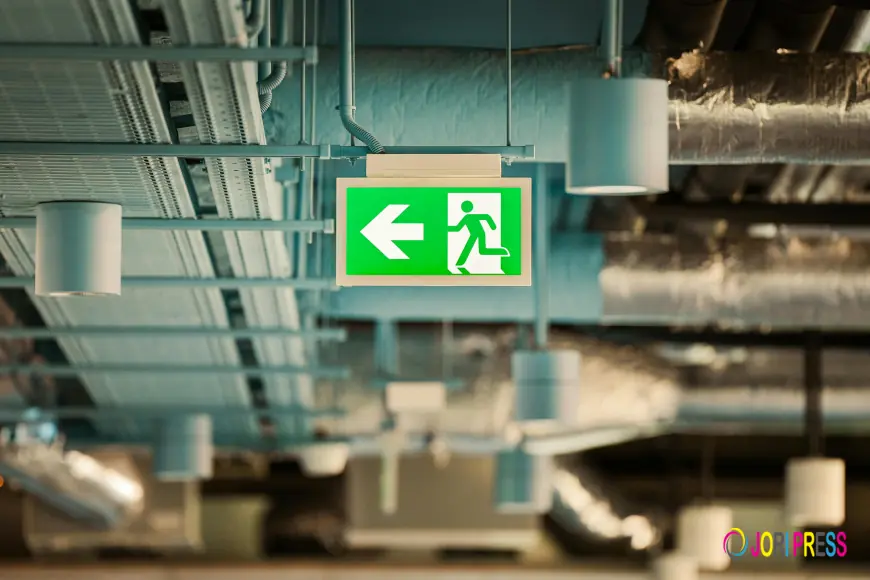Your Exit Lighting Checklist: Testing, Maintenance & Safety Tips
Ensure safety and compliance with reliable Exit Emergency Lighting Tests. Learn how testing, maintenance and clear evacuation planning protect your workplace.

Exit lighting is one of the most overlooked components of workplace safety, yet it plays an essential role in guiding people out of a building during an emergency. An Exit Emergency Lighting Test Melbourne ensures that your exit and emergency fittings are functioning correctly, remain compliant, and can be relied on during a fire or power outage. When combined with proper fire protection measures, electrical test tag procedures, Fire extinguisher test and tag requirements, and a clear evacuation map, exit lighting becomes part of a complete safety ecosystem that protects lives.
Understanding Why Exit Lighting Matters
Exit lighting is not just another box to tick on a compliance checklist. It provides critical visual guidance when visibility drops, leading people safely through corridors, stairwells, and emergency exits. In a fire event where smoke, confusion, and time pressure take over, illuminated paths become lifesaving tools. Without a properly maintained system, even a well-designed evacuation route can fail.
An Exit Emergency Lighting Test allows you to identify faults early, correct issues before they become hazards, and maintain legal compliance under Australian Standards. The reliability of these lights directly affects how efficiently occupants can evacuate during an emergency.
What Your Exit Lighting Test Should Include
A thorough testing routine involves more than switching lights on to confirm they work. The assessment must include functional checks, discharge tests, battery condition reviews, visual inspection of fittings, and the ability of the lights to operate independently during a simulated power loss. Every component that contributes to visibility, from the brightness of the lamp to the wiring behind the fitting, must be evaluated.
Proper documentation is required after each Exit Emergency Lighting Test. Recording details such as test dates, performance results, and identified faults ensures your system remains compliant. These records also support insurance requirements and protect your organisation during audits.
Maintenance Tasks That Keep Your System Reliable
Ongoing maintenance is essential for ensuring emergency lighting continues to operate effectively long after installation. This involves inspecting fittings for damage, checking for signs of corrosion, ensuring batteries hold charge, verifying that signs are unobstructed, and replacing faulty components promptly. Maintenance should also include ensuring pathways beneath illuminated exit signs are clear, clean, and properly marked on the emergency evacuation map.
The overall fire protection framework of your building relies heavily on well-maintained lighting. If exit paths are compromised or poorly lit, even the best fire extinguishers, signage, and alarms become less effective during an emergency.
How Exit Lighting Supports Other Safety Systems
Emergency lighting does not work alone. It supports and enhances other fire safety tools and systems. Fire extinguisher test and tag procedures ensure critical equipment works when needed, but without visibility, people may struggle to locate extinguishers or emergency exits. Similarly, electrical test tag programs reduce the risk of electrical faults, but during power interruptions caused by electrical failures, emergency lighting ensures safe movement through the building.
Evacuation plans also rely on clearly illuminated paths. A well-designed emergency evacuation map is only helpful when the physical environment mirrors what is shown on the diagram. Proper placement of illuminated exit signs reinforces the evacuation route and makes it easier to follow even in low-visibility conditions.
Recognising the Signs of a Failing System
Emergency lighting can deteriorate subtly. Signs of poor performance may include flickering lights, discoloured fittings, weak illumination, slow start-up times, or lights that fail during simulated outages. Batteries that drain quickly or fittings that show physical wear should be replaced immediately.
If your Exit Emergency Lighting Test repeatedly shows issues, it is important to address underlying electrical problems rather than relying solely on surface-level repairs. Regular testing ensures small faults are caught before they become major hazards.
Understanding Compliance Requirements in Australia
Australian businesses must meet specific safety standards regarding emergency and exit lighting. Compliance involves performing routine discharge tests, maintaining detailed logbooks, repairing or replacing failed components, and ensuring lights are set up in accordance with building layout and designated evacuation routes. Non-compliance can lead to penalties, insurance complications, and increased safety risks for employees and visitors.
Australian Standards emphasise the importance of reliable lighting during emergencies. Whether it is a fire, power failure, or another hazard, properly tested lighting ensures that evacuation can occur safely and efficiently.
Integrating Exit Lighting Into a Comprehensive Safety Plan
Emergency lighting is one element of a broader fire protection strategy. To achieve a safe workplace, your safety plan should include a combination of tested appliances, clear evacuation routes, trained staff, and reliable equipment. Fire protection measures work best when each element is functioning at its highest standard.
Regular Fire extinguisher test and tag services ensure extinguishers are ready for use. Electrical test tag routines reduce fire risk from faulty appliances. Up-to-date evacuation maps give teams a clear route. When all these components work together, your workplace benefits from a cohesive and effective safety system.
The Importance of Professional Testing
While some general inspections can be done internally, a professional inspection ensures compliance with all relevant standards. Trained technicians use specialised tools to assess battery performance, simulate blackout conditions, and identify electrical or structural issues that may go unnoticed. Professional guidance ensures your emergency lighting supports your evacuation strategy and meets the requirements of your building.
Engaging experts ensures that the Exit Emergency Lighting Test is carried out correctly, that maintenance is recorded properly, and that any risks are addressed promptly. This level of support becomes especially important during audits, insurance assessments, and emergency response planning.
Make your workplace safer and fully compliant with professional emergency lighting assessments. Contact Australia Fire Protection today to schedule your Exit Emergency Lighting Test, update your evacuation planning, and strengthen your overall fire safety system.
What's Your Reaction?
 Like
0
Like
0
 Dislike
0
Dislike
0
 Love
0
Love
0
 Funny
0
Funny
0
 Angry
0
Angry
0
 Sad
0
Sad
0
 Wow
0
Wow
0





















































